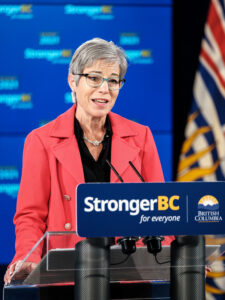
The federal government’s first budget in two years was tabled Monday, followed by BC Budget day on Tuesday. Here are some highlights for the community social services sector from those two budgets.
For our sector, the Supplement to the Estimates is the low-key home to the numbers that matter most to our sector – the Standard Objects, aka STOBs.
STOBs are line items in each ministry’s plan, and the ones that matter to our sector are STOB 77 and 80. They indicate how much money will be going out either as grants (STOB 77) or reimbursements for contracted services (STOB 80). STOBs are not specific to the non-profit sector, but they are the line items that indicate how much each ministry is committing in third-party contracts.
STOB 80s for five of our sector’s key funding ministries – Advanced Education, MCFD, Health, Public Services and Solicitor General, and Social Development and Poverty Reduction –all appear to have increased their third-party contract amounts compared to last year’s budget. However, other organizations’ analyses of the STOB 80 figures have concluded that the minimal uplift will barely cover wage increases for existing contracts in our sector.
Here are STOB 80s for these ministries:
- Advanced Education – $313 million, up from $250 million in 2020-21
- MCFD – $1.65 billion, up from $1.5 billion
- Health – $8 billion, up from $7.6 billion (unclear whether contracts with health authorities are included in this)
- PSSG – $576 million, up from $505 million
- SDPR – $1.78 billion, up from $1.6 billion
A review of these ministries’ three-year plans makes it very clear that we are in for flat-line budgets in the social ministries right through 2023-24 as the government works to reduce its $9.7 billion deficit to $4.3 billion by 2023-24.
Other BC budget highlights relevant to our sector:
- Childcare is big in both the provincial and federal budgets. The province is aiming to double the number of $10-a-day childcare spaces and will boost wages for early childhood educators in licenced facilities by $2 an hour. The number of spaces in the Aboriginal Head Start program will increase to 1,000 from the current 600. The federal government, meanwhile, has pledged almost $30 billion over the next five years targeted at accessible, affordable childcare.
- Foundry centres, providing wraparound mental health and addiction services to children and youth ages 12 to 24, will be expanding into more communities. There are currently nine Foundry centres open in BC, with a plan to increase that to 23 centres by 2023-24.
- Services for children and youth with special needs will see a $30 million jump to $440 million this year, but that will fall back to $432 million for the next two years. Services for child and youth mental health is also getting a boost, though much of that will go toward the new Foundries and for expanding the new Integrated Child and Youth Team approach from five school districts to 15.
- Community Living BC will receive $367 million in new funding over the next three years to provide supports and services to the more than 25,000 adults with developmental disabilities and their families who receive CLBC support (the caseload grows by about five per cent a year). Of note: CLBC is anticipating a loss of paid work for the people it serves, with the percentage of clients under 65 who have earned income forecast to fall from 24 per cent currently to 20 per cent in three years, and the number of those who have retained employment for a year or more falling from 81 per cent to 70 per cent.
- Seniors will benefit from a $68 million lift over three years aimed at improving the quality of homecare by increasing the number of care aides and other community care providers that do that work. Low-income seniors will see a $50 boost in the seniors’ supplement – the first lift since 1987!
Housing is a focus of both the provincial and federal budgets, with the feds pledging more than 35,000 affordable homes and funding for the Canadian Mortgage Housing Corporation to repair existing affordable housing units.
Provincially, there will be more money to extend supports and services for people experiencing or at risk of homelessness, and a plan for 10,000 new housing units over the next three years through grand funding to non-profit housing providers, with a focus on middle-income families, seniors, Indigenous Peoples, and women and children leaving violence. (Check out this BC Housing map of all housing projects in BC)
The federal budget brought word of a new $400 million temporary fund, the Community Services Recovery Fund, to help charities and non-profits “adapt and modernize so they can better support the economic recovery in our communities.” No details yet on what that fund will look like or how it will be administered, but we’ll be watching for more to share with you.
As well, the federal government is tossing around the idea of a “home in government” for charities, which the BC government has recently done by creating a Parliamentary Secretary for Community Development and Non-Profits within the Social Development Ministry. Ottawa is also considering expansion of borrower eligibility for the Canada Small Business Financing Program to include non-profit and charitable social enterprises.
